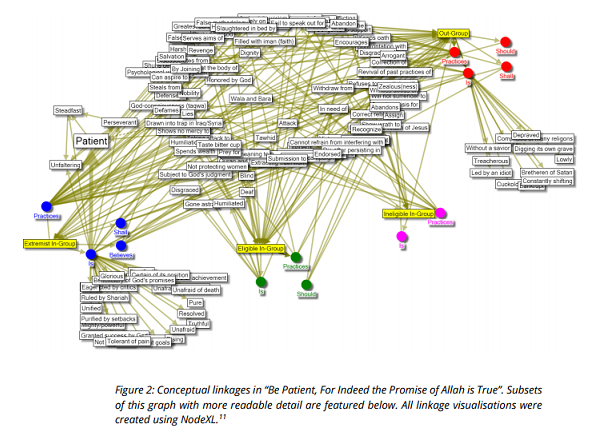JM Berger, Extremism — you have been alerted, informed
Wednesday, April 18th, 2018[ posted for your considerable edification by Charles Cameron — tweet-stream by JM Berger ]
.
Friend JM Berger‘s recent work sums to a book to be published in September. This tweet-stream brings you up to date on his process.
You have been invited.
**
My year-in-review thread: This year I've been working a fairly unified theme, developing a framework for studying extremism and radicalization. pic.twitter.com/PuIk2rcXSC
— ?.?. ?????? (@intelwire) December 23, 2017
___________________________
The most important piece of this was Extremist Construction of Identity, a paper published by the Counter Terrorism Strategic Communications program at @ICCT_TheHague https://t.co/HwOXkfAqkt pic.twitter.com/9Ou8izCqNZ
— ?.?. ?????? (@intelwire) December 23, 2017
**
The framework was derived from a detailed analysis of the ideology that spawned Christian Identity, a violent white nationalist belief system. In two follow-up papers, I applied the framework to the ideology of ISIS.
— ?.?. ?????? (@intelwire) December 23, 2017
___________________________
The first, presented at Europol and published by @ICCT_TheHague looked at a historical piece of ISIS propaganda https://t.co/fbBYlhmekg pic.twitter.com/4rXmHgMyrx
— ?.?. ?????? (@intelwire) December 23, 2017
___________________________
The second, published by @ICCT_TheHague, looked at a more recent piece of ISIS propaganda, suggesting messaging strategies in light of its disastrous loss of territory https://t.co/ksLNkEe5rI pic.twitter.com/hyWG9bT8ys
— ?.?. ?????? (@intelwire) December 23, 2017
___________________________
All of this raises the question of what policy makers mean when they say they're going to "defeat the extremist ideology" https://t.co/Bt9Z6VX0u5
— ?.?. ?????? (@intelwire) December 23, 2017
___________________________
This research also helped inform a piece for @WarOnTheRocks about the alarming current U.S. political situation https://t.co/oFKy5IzgQS
— ?.?. ?????? (@intelwire) December 23, 2017
___________________________
Relatedly, I wrote about the Trump administration's malevolent dismantling and rebranding of CVE https://t.co/IXqiE04dEy
— ?.?. ?????? (@intelwire) December 23, 2017
___________________________
Before I leave the topic of politics, I also teamed up with @selectedwidsom, @webradius, @jonathonmorgan and @SecureDemocracy on the #Hamilton68 dashboard tracking Russian influence operations https://t.co/xXPx6poBbm https://t.co/LEkzNxfv3m
— ?.?. ?????? (@intelwire) December 23, 2017
___________________________
Back to the extremist identity research, which also informed a piece for @TheAtlantic about the cycle of radicalization between the far-right and jihadists https://t.co/f9skMxaPqm
— ?.?. ?????? (@intelwire) December 23, 2017
___________________________
In a talk at @IEAdeParis I discussed the link between extremist identity construction and uncertainty, to be further developed in my next book (fall 2018) https://t.co/O40eyyP8Pe
— ?.?. ?????? (@intelwire) December 23, 2017
___________________________
More recently, @AmarAmarasingam and I talked about issues related to ISIS and uncertainty in a piece for @monkeycageblog https://t.co/9l708HuVhP
— ?.?. ?????? (@intelwire) December 23, 2017
___________________________
Most of this work was pretty focused on a singular goal of developing and fleshing out an evidence-based framework for studying extremism across different ideologies. pic.twitter.com/d0QM1cqKcr
— ?.?. ?????? (@intelwire) December 23, 2017
___________________________
That research will be an even bigger focus in the year to come, including through the new book, another book in the works, some exciting projects in the alt-right space, and some major research projects I hope to announce soon. Thanks for following, and stay tuned! pic.twitter.com/RfVeSXUyuP
— ?.?. ?????? (@intelwire) December 23, 2017
___________________________
Kicking off 2018 https://t.co/qh60nIAvf8
— ?.?. ?????? (@intelwire) February 7, 2018
___________________________
Pre-orders are now open for my next book, Extremism, out in September. I think it's going to spark some much-needed debate about what kind of people we call extremists and what kind we don't. Here's the opening paragraph… https://t.co/OTciSQH99N pic.twitter.com/ZyEUZPQRj5
— ?.?. ?????? (@intelwire) April 3, 2018
___________________________
Extremism, my next book, comes out in September. I'm looking to spark some debate in national security circles about how we define it. More details soon.
Paperback: 200 pages
Publisher: The MIT Press (September 7, 2018)https://t.co/aT77UDktLT pic.twitter.com/n9l83wkMHh— ?.?. ?????? (@intelwire) April 15, 2018
_________________________
And that’s it.







